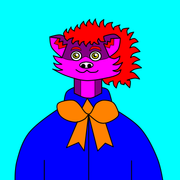 To Nahobino Be the Glory
To Nahobino Be the GloryAtlus’s Megami Tensei series has in recent years become one of my favorite Japanese roleplaying game franchises, having successfully broken out of its niche to become more accessible to those who would normally not enjoy games of its kind, given features such as strategic gameplay coupled with occasional features to stave off frustration such as adjustable difficulty settings. Thus, with high expectations I dove into the fifth mainline entry of the primary series,
Shin Megami Tensei V on the Nintendo Switch, which continues to bring the franchise forward with old and new features alike, delivering another enjoyable title among the flagship Atlus games.
The narrative opens with a Japanese high schooler whom the player names experiencing doomsday, saved from death by a godly being known as the Aogami and fusing with him to become the Nahobino. The plot is generally enjoyable, with plenty of mature themes, religious overtones, nice backstory, and occasional philosophical choices that customize the ending, although there are plenty similarities to the plots of previous Shin Megami Tensei titles, such as the clash between law and chaos and the general apocalyptic focus. The translation mercifully doesn’t mar the story, with Atlus doing things such as not keeping Japanese honorifics untranslated, but there are occasional stylistic oddities with regards to demon negotiation dialogue and the off-lip movement during cutscenes.
Luckily, enjoyable mechanics back up the fifth entry, with many elements returning from prior titles such as demon negotiation requiring money, various consumables, and sometimes the Nahobino’s health and magic points, and enemies rarely, if ever, flake out on negotiation aside from “incorrect” answers during the initial phases of intercession. The Press-Turn Icon system from
Nocturne onward returns as well, with the exploitation of enemy weaknesses (which the game luckily records during subsequent encounters with the same demons) only consuming half of one of up to four of the player’s Icons, whereas foes nullifying attacks consumes two, and using abilities that heal enemies or reflect back at the player instantly ends their turn session (the same rules applying to opponents).
A major new feature in
Shin Megami Tensei V is the use of Essences gained from demons or gold treasure orbs to adjust the strengths and weaknesses of the Nahobino or one of his demons, or customize their skill setups, with a potential maximum of eight abilities. Increasing ability slots from the default of four for both the Nahobino and his demons requires the acquisition of Miracles (replacing Apps from the fourth mainline game and its direct sequel) through Glory gained from finding Miman, where acquiring a certain number grants him bonuses at the shop accessible from any save fount, or from special silver orbs, which are a more significant source.
The player unlocks new Miracles by defeating reddish weblike entities that obscure their view of the in-game maps for the various overworlds, which in turn remove said visual obstruction. There are four types of Miracles, some which can enhance demon negotiation, for instance, giving the player a free pass if they in any way screw up said intercession. Others can expand the player’s maximum demon stock (though as I constantly fused whichever demons I obtained, I didn’t have much use for an increased number of maximum allies), or grant bonuses to the use of different ability types such as the various magical elements, stat increasing/decreasing skills, or physical attacks/abilities.
Demon fusing does indeed return, with players able to perform standard fusions of two demons to create a new one, which I regularly accomplished to discover new demons, or perform special fusions for want of defeated bosses in their party that in many cases require more than two demons. As demons gain levels and acquire increased stats and new skills, the player can register them in the returning Demon Compendium for latter resummoning at the price of Macca gained from completing quests, gold treasure orbs, or from combat in the form of winning the battle or occasionally conversing with a demon that’s in their party at the time.
One handy feature new to the fifth game is “reverse fusion” where players can see fusable demons from those in their party and/or those from which they’ve registered in the Compendium, which will satisfy completionists seeking to fill the in-game register. Given this and the gameplay’s myriad of features, including a more-than-casual difficulty as free downloadable content, it very well shines, retaining the strategic gameplay of its predecessors whilst accommodating players of different skill levels. Pretty much the only real hiccup is the possibility to waste money and items trying to recruit demons that are above the Nahobino’s current level, but otherwise, there’s little, if anything, of which to complain.
Control is just as solid, with the aforementioned quality-of-life features during demon fusion being a definite boon, alongside the ability to sort possible fusions by different categories such as cost. The general game interface is easily navigable as well, with shopping being nonproblematic and movement control on the overworld and in dungeons faring smoothly, alongside features such as the ability to teleport instantly back to the last save fount and a shortcut to using healing magic to bring the player’s party back to full health, provided the necessary recovery skills are available. There are a few issues such as the irritating level design at times, the ability to view playtime only when recording progress, and unskippable text during many voiced cutscenes (though these are most of the time both pausable and skippable), but generally,
Shin Megami Tensei V interacts well with players.
The aforementioned voicework is mostly solid in spite of some irritating performances mainly among the demons with whom the Nahobino interacts, and while there is some good music mainly in battle, most of the soundtrack is relatively bland and often too ambient.
The graphics look decent, with good character and demon designs minus any reskins, nice colors that very well convey the game’s post-doomsday disposition, vivid effects in combat especially prominent when demons meet their ends, lip movement during voiced scenes, and a dodge animation on part of the Nahobino’s allies that looks significantly less asinine than in other of the franchise’s entries within and without the primary Shin Megami Tensei subseries. There are some technical issues such as jaggies prominent in many games with three-dimensional visuals, some choppiness, plentiful environmental popup, and poor collision detection, but otherwise, the visuals are hardly an eyesore.
Finally, the fifth game is fairly shorter than its predecessors (with my final playtime somewhere around thirty-four hours), although there’s sizeable lasting appeal in the form of sidequests, completing the Demon Compendium, different story decisions, and a New Game+ where players can carry over elements from prior playthroughs, although akin to other Nintendo Switch games, there isn’t any tracking of achievements like Trophies for PlayStation games.
On the whole,
Shin Megami Tensei V is another great addition to its franchise, given its solid mechanics appealing to different kinds of players, general user-friendliness, philosophical choices determining the ending, and solid localization expectant from a company like Atlus. It does have flaws preventing it from achieving excellence such as the level design at points, the story’s similarities to those of prior mainline titles, the relative forgetfulness of the soundtrack, and the technical issues with the graphics, although it’s definitely another feather in the cap of a series whose quality has, for the most part, especially during the past decade, been mostly consistent, in other words, well above average.
This review is based on a single playthrough to one of the standard endings of a copy borrowed by the reviewer.The Good:+Solid mechanics with adjustable difficulty.
+Tight control with clear direction.
+Different narrative decisions.
+Polished localization.
The Bad:-Some annoying level designs.
-Story similar to previous series entries.
-Music a bit bland.
-Many technical hiccups with the visuals.
The Bottom Line:Another enjoyable entry of the franchise.
Score Breakdown:Platform: Nintendo Switch
Game Mechanics: 9.5/10
Controls: 9.0/10
Story: 7.5/10
Localization: 8.5/10
Music/Sound: 7.5/10
Graphics: 8.0/10
Lasting Appeal: 9.5/10
Difficulty: Adjustable
Playing Time: 24-48 Hours
Overall: 8.5/10
 The Last Druid by Terry Brooks
The Last Druid by Terry Brooks













